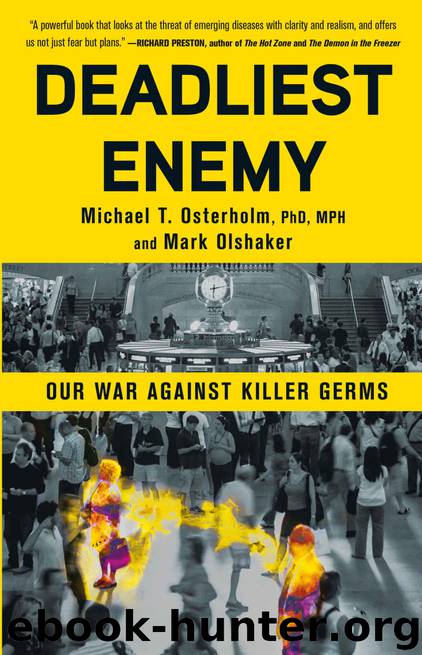Deadliest Enemy: Our War Against Killer Germs by Michael T. Osterholm & Mark Olshaker

Author:Michael T. Osterholm & Mark Olshaker [Osterholm, Michael T.]
Language: eng
Format: epub
Tags: Medical / Infectious Diseases, Medical / Epidemiology, Medical / Public Health, Science / Life Sciences / Biology
ISBN: 9780316343695
Publisher: Little, Brown and Company
Published: 2017-03-14T07:00:00+00:00
The potential for similar outbreaks anywhere in the world should be noted from a single traveller as long as MERS-CoV transmission continues in the Middle East. Emergency preparedness and vigilance are critical to prevent further large outbreaks in the future. Our report serves as an international alarm that preparedness in hospitals, laboratories, and governmental agencies is the key not only for MERS-CoV infections but also for other new emerging infectious diseases.
There is no question in my mind that the Korean outbreak will not remain an isolated incident in the natural history of MERS. Wherever it strikes next, hospitals and public health officials will face the same challenges.
So when it comes to MERS, we are facing two big issues. There is no reason to assume that the next outbreak will be confined to one city or region as it was in Korea. If the virus does find its way onto the African continent, it will be extremely difficult to eliminate or even control. We have an opportunity now to do something decisive before that happens, but the window won’t stay open indefinitely.
As we were completing this book, the WHO put out a comprehensive document: A Roadmap for Research and Product Development Against Middle East Respiratory Syndrome: Coronavirus (MERS CoV). It defines the critical product development needed to hit MERS head-on. Both human and camel vaccines are top priorities. The road map also prioritizes effective treatments and better diagnostic testing.
MERS vaccine research and development has also been identified as a priority by the Foundation for Vaccine Research, the Norwegian Institute of Public Health, and CEPI. Will a vaccine ever become a reality? I don’t know, as there is no prospective pot of money at the end of the vaccine research and development rainbow. Nor is there a Manhattan Project–like authority to direct such an effort. I fear the WHO road map document will grow dusty on office shelves. I have personally experienced this. At CIDRAP, we produced a comprehensive report on the need for game-changing influenza vaccines that has been ignored for years. You will read about it in our final chapter.
The SARS outbreak has left the world one legacy that continues to haunt us today. A number of vaccine research, development, and manufacturing companies stepped forward in the early days of the SARS outbreak in 2003 at the request of the WHO and invested many millions of dollars in SARS vaccine work. I’m not aware that anyone knows exactly how much was invested across the pharmaceutical industry, but it’s likely in the hundreds of millions of dollars. The industry wanted to do the right thing by assisting the world in responding to this public health crisis, and to capitalize on an investment opportunity.
When the outbreak was extinguished by the end of the summer of 2003, interest from government agencies and philanthropic organizations to support additional research on a SARS vaccine virtually disappeared. There was no interest registered at the time for ever buying such a vaccine. The companies were left largely holding the bag for the early SARS vaccine research costs.
Download
This site does not store any files on its server. We only index and link to content provided by other sites. Please contact the content providers to delete copyright contents if any and email us, we'll remove relevant links or contents immediately.
Periodization Training for Sports by Tudor Bompa(8170)
Why We Sleep: Unlocking the Power of Sleep and Dreams by Matthew Walker(6618)
Paper Towns by Green John(5089)
The Immortal Life of Henrietta Lacks by Rebecca Skloot(4525)
The Sports Rules Book by Human Kinetics(4294)
Dynamic Alignment Through Imagery by Eric Franklin(4116)
ACSM's Complete Guide to Fitness & Health by ACSM(3989)
Kaplan MCAT Organic Chemistry Review: Created for MCAT 2015 (Kaplan Test Prep) by Kaplan(3939)
Introduction to Kinesiology by Shirl J. Hoffman(3725)
Livewired by David Eagleman(3683)
The Death of the Heart by Elizabeth Bowen(3551)
The River of Consciousness by Oliver Sacks(3539)
Alchemy and Alchemists by C. J. S. Thompson(3449)
Bad Pharma by Ben Goldacre(3355)
Descartes' Error by Antonio Damasio(3230)
The Emperor of All Maladies: A Biography of Cancer by Siddhartha Mukherjee(3064)
The Gene: An Intimate History by Siddhartha Mukherjee(3047)
The Fate of Rome: Climate, Disease, and the End of an Empire (The Princeton History of the Ancient World) by Kyle Harper(3003)
Kaplan MCAT Behavioral Sciences Review: Created for MCAT 2015 (Kaplan Test Prep) by Kaplan(2936)
